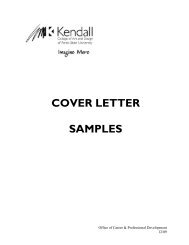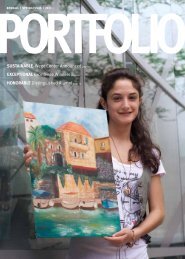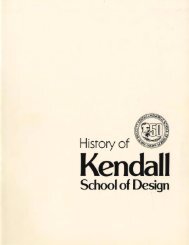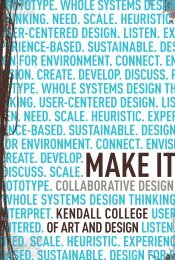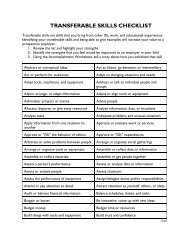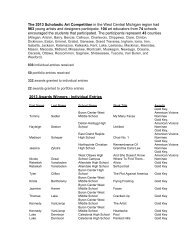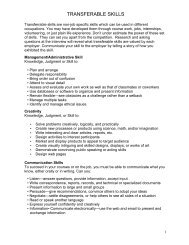Download - Kendall College of Art and Design
Download - Kendall College of Art and Design
Download - Kendall College of Art and Design
You also want an ePaper? Increase the reach of your titles
YUMPU automatically turns print PDFs into web optimized ePapers that Google loves.
Left:<br />
Innovative materials displayed in the Material<br />
ConneXion library<br />
Right, left to right:<br />
<strong>Art</strong>Prize entries by Je’siq <strong>and</strong> Horst, Mimi<br />
Kato, <strong>and</strong> Jonathan Brilliant<br />
Presidential Search Begins<br />
Searching for the next leader <strong>of</strong> <strong>Kendall</strong> <strong>College</strong> <strong>of</strong> <strong>Art</strong> <strong>and</strong> <strong>Design</strong> is no easy task. Just ask Dean<br />
Max Shangle <strong>and</strong> <strong>Art</strong> Education Program Chair Cindy Todd, who are co-chairing <strong>Kendall</strong>’s presidential<br />
search committee.<br />
Before the two could institute the search process, they first had to build their team – a process nearly<br />
as difficult as the search for a president. “We wanted to put together a team that best represented all<br />
facets <strong>of</strong> the college, a blend <strong>of</strong> administration <strong>and</strong> programs. A lot <strong>of</strong> people were willing to participate,<br />
but we were cognizant <strong>of</strong> the drawbacks <strong>of</strong> a committee that was too large, or too small,” says Shangle.<br />
Adds Todd, “It’s an important part <strong>of</strong> the process, making sure that faculty, staff, students <strong>and</strong> the public<br />
have an opportunity to have a voice in choosing <strong>Kendall</strong>’s next leader. The final committee is a great<br />
360-degree representation.”<br />
Team members who represent different aspects <strong>of</strong> the college are Admissions, S<strong>and</strong>y Britton; Administration,<br />
Barbara Boltman; Student Activities, Nicole DeKraker; Facilities, Brent Hulbert; Metals/Jewelry, Phil<br />
Renato; Illustration, Jon McDonald; Interior <strong>Design</strong>, Olivia Snyder; Graphic <strong>Design</strong>, Ron Riksen; Painting,<br />
Patricia Constantine; <strong>and</strong> alumna <strong>and</strong> friend <strong>of</strong> <strong>Kendall</strong>, Valerie Schmieder. Ferris State University<br />
President David Eisler is also involved with the committee. “He is as committed to this search as we<br />
are,” says Todd.<br />
RPA Executive Search & Consulting is conducting the actual search. Although RPA specializes in<br />
academic searches, the net will be flung far <strong>and</strong> wide, reaching out to nontraditional c<strong>and</strong>idates as<br />
well as traditional academic leaders. “There’s no reason we couldn’t hire someone from business or<br />
industry. We’re searching for a leader who underst<strong>and</strong>s the role <strong>of</strong> an art <strong>and</strong> design college <strong>and</strong> its<br />
potential influence on the business <strong>of</strong> design,” says Shangle.<br />
The firm visited <strong>Kendall</strong> in mid-September <strong>and</strong> met with different constituencies to gather the voice<br />
<strong>of</strong> the college as to important attributes <strong>of</strong> the new president. “Then the search committee will work<br />
with RPA to develop a position description <strong>and</strong> advertising. C<strong>and</strong>idates will be reviewed in November,<br />
initial interviews held in December <strong>and</strong> on-campus interviews conducted in January, with a possible<br />
announcement by the end <strong>of</strong> February. At least, that’s the plan,” says Shangle, who quickly points out<br />
that they will not “settle” on a c<strong>and</strong>idate who is not a perfect fit. “If we don’t hear from the caliber <strong>of</strong><br />
c<strong>and</strong>idates we’re hoping for, we’ll regroup <strong>and</strong> start again.”<br />
Once the search committee begins to deal with documents <strong>and</strong> c<strong>and</strong>idates, the dem<strong>and</strong>s on their time<br />
<strong>and</strong> energy will be difficult, but Shangle <strong>and</strong> Todd feel the group is up to the task. “After all, this is<br />
serious business. We’re selecting the person who will conceivably be the leader <strong>of</strong> <strong>Kendall</strong> for the next<br />
20 years,” Shangle says. “The selection will be our legacy,” adds Todd, “since it’s quite possible that<br />
many <strong>of</strong> us will retire within that time.”<br />
And when the perfect c<strong>and</strong>idate is selected, it’s possible the new president will not immediately take<br />
the helm. “The kind <strong>of</strong> person we are hoping to hire will have deep roots in their community; he or she<br />
cannot just give two weeks’ notice <strong>and</strong> begin at <strong>Kendall</strong>,” Shangle adds.<br />
Both Todd <strong>and</strong> Shangle are looking forward to the process <strong>of</strong> choosing <strong>Kendall</strong>’s next leader. “Personally,<br />
I’m looking for someone who has a clear world view from all perspectives – someone who is a visionary<br />
<strong>and</strong> will bring us a fresh outlook,” says Todd. “But no matter who is chosen, we are going to see change<br />
here. My hope is that we hire someone who, in 20 years, everyone will be sad to see go.” Shangle agrees.<br />
“We are not the same college as we were when Oliver (Evans) became president. The face <strong>of</strong> the college<br />
has changed significantly during his tenure. And thanks to his leadership, we have the opportunity to<br />
choose a leader who will continue to seize opportunities presented to us.”<br />
Material ConneXion<br />
Resource Center:<br />
Something Old,<br />
Something New<br />
The Material ConneXion Resource Center<br />
could be called a materials library, but that<br />
would be selling it short. And although<br />
Interior <strong>Design</strong> Pr<strong>of</strong>essor Tara McCrackin is<br />
the “librarian,” to believe that the materials<br />
in the collection are limited to interiors would<br />
also be doing the resource a great disservice.<br />
“I like to tell people that Material ConneXion<br />
refers to a variety <strong>of</strong> materials that connect<br />
to each other in ways you might not be aware<br />
<strong>of</strong>, such as a covering for coaxial cable that<br />
Nike has incorporated into a line <strong>of</strong> athletic<br />
footwear,” says McCrackin. But the collection<br />
is not limited to the latest technologically<br />
advanced materials. “Here’s my favorite at<br />
the moment,” she says. “It’s leather made<br />
<strong>of</strong> stingray hide. It’s a byproduct <strong>of</strong> the food<br />
industry, can be dyed <strong>and</strong> is used in fashion.<br />
I did some research <strong>and</strong> discovered that<br />
13th-century samurai warriors wrapped their<br />
sword h<strong>and</strong>les with it.”<br />
There are approximately 6,000 materials<br />
in the entire collection (which is accessible<br />
through the Material ConneXion database),<br />
<strong>and</strong> 1,200 are displayed in the New York<br />
showroom. At 300 pieces, <strong>Kendall</strong> has one <strong>of</strong><br />
the largest collections outside <strong>of</strong> New York<br />
<strong>and</strong> the largest academic collection, which is<br />
set to exp<strong>and</strong> by 100 pieces with the move to<br />
the Federal Building.<br />
In its new facility in the Wege Center for<br />
Sustainable <strong>Design</strong> at the Federal Building,<br />
the collection will have space to exp<strong>and</strong>;<br />
visitors will have workspace to lay out the<br />
sample boards as they work on their designs.<br />
Visitors will be able to search the database<br />
<strong>and</strong> see results on a very large flat screen.<br />
“There are a couple <strong>of</strong> different ways to<br />
access the database. Users can search by<br />
database number, category, or a term such<br />
as material or color. Each database entry<br />
lists the properties <strong>and</strong> provides links to the<br />
manufacturer,” says McCrackin.<br />
As its “ambassador,” McCrackin has sung<br />
Material ConneXion’s praises to numerous<br />
departments. “Industrial <strong>and</strong> Furniture<br />
<strong>Design</strong> students are the most frequent<br />
visitors, but word is spreading. Photography<br />
students have used different materials for<br />
the booklets they are required to produce,<br />
<strong>and</strong> Graphic <strong>Design</strong> students are exploring<br />
the collection for ideas,” she says. “Word<br />
is spreading, <strong>and</strong> we update fans on our<br />
Facebook page (<strong>Kendall</strong> <strong>College</strong> <strong>of</strong> <strong>Art</strong> <strong>and</strong><br />
<strong>Design</strong> – Material ConneXion).”<br />
“At this time, it is uncertain if or how the<br />
public will be able to access the collection,”<br />
says Dean Max Shangle. “We know that<br />
if students are working on a project with<br />
representatives <strong>of</strong> a local company or industry,<br />
those pr<strong>of</strong>essionals will be able to access the<br />
collection in order to help the students. After<br />
the move to the Federal Building, we’ll have<br />
to see to what extent we can share this great<br />
resource with the design community.”<br />
Fashion Studies: A<br />
New Form <strong>of</strong> <strong>Design</strong><br />
Although many existing programs (<strong>Art</strong><br />
History, Gen Ed, Continuing Studies,<br />
Sculpture <strong>and</strong> Functional <strong>Art</strong>) will soon call<br />
the Federal Building home, the new BFA in<br />
Fashion Studies will be taught there as well.<br />
Three years in the making, the program is<br />
designed as a “3+1,” meaning students will<br />
attend <strong>Kendall</strong> for three years, then complete<br />
their final year at FIT, the Fashion Institute <strong>of</strong><br />
Technology in New York.<br />
One might be tempted to call the program<br />
“fashion design,” but Dean Max Shangle<br />
is quick to point out that it isn’t. “Fashion<br />
design is a very distinct program path. If we<br />
were to focus solely on design, we couldn’t<br />
give an opportunity to students interested<br />
in related fields, such as fashion marketing<br />
or merch<strong>and</strong>ising. Fashion Studies will <strong>of</strong>fer<br />
industry depth <strong>and</strong> breadth, similar to our<br />
Furniture <strong>Design</strong> <strong>and</strong> Metals/Jewelry <strong>Design</strong><br />
programs.”<br />
Consultants Mimi Ray <strong>and</strong> Andrea Reynders<br />
have studied various programs from across<br />
the country <strong>and</strong> utilized their vast network <strong>of</strong><br />
industry pr<strong>of</strong>essionals in order to recommend<br />
the curriculum. Reynders, Pr<strong>of</strong>essor <strong>and</strong><br />
Sage Endowed Chair in Fashion <strong>Design</strong> at<br />
the School <strong>of</strong> the <strong>Art</strong> Institute <strong>of</strong> Chicago,<br />
concentrated on the academic portion <strong>of</strong> the<br />
program. Ray, who holds a degree in fashion<br />
design from the School <strong>of</strong> the <strong>Art</strong> Institute,<br />
utilized her 10 years <strong>of</strong> experience in the<br />
industry, having worked in Paris as a designer<br />
as well as traveled throughout the world,<br />
from Berlin to Hong Kong. Says Shangle,<br />
“We wanted this program to be developed<br />
by people who know the industry inside <strong>and</strong><br />
out – who are familiar on a higher level.”<br />
Specifics <strong>of</strong> the program have yet to be<br />
completed, but it is certain Fashion Studies<br />
students will be required to be well-versed in<br />
fundamental skills, such as sewing, draping<br />
<strong>and</strong> construction. “Our students are required<br />
to take 2-D, 3-D <strong>and</strong> drawing; in addition,<br />
fashion students will be required to have<br />
rigorous studio experience in the fashion<br />
basics,” says Shangle.<br />
In their fourth year, students will travel to FIT<br />
for final classes in the heart <strong>of</strong> New York’s<br />
fashion district. “After all, we are in the<br />
Midwest, which isn’t the fashion capital <strong>of</strong> the<br />
world,” laughs Ray. Shangle adds, “Studying<br />
at FIT will not only broaden their horizons,<br />
but give them access to industry connections<br />
that simply aren’t available here.”<br />
Ray’s goal is that students will be able to<br />
take their fashion skills <strong>and</strong> knowledge <strong>and</strong><br />
apply them to any “fashionable” industry.<br />
“In the end, students will have a skill set<br />
they can take anywhere, from working for<br />
an ad agency, developing a visual identity<br />
or forecasting trends to designing theatrical<br />
costumes or becoming a celebrity stylist.”<br />
Shangle concludes, “This program will develop<br />
another type <strong>of</strong> visual communicator <strong>and</strong> help<br />
them find their own voice through fashion –<br />
another form <strong>of</strong> design.”<br />
2011 <strong>Art</strong>Prize <strong>Art</strong>ists ExhibitED<br />
KENDALL GALLERY<br />
Consider the humble c<strong>of</strong>fee stirrer: those tiny wooden sticks that are used once or twice <strong>and</strong> then thrown<br />
away. North Carolina artist Jonathan Brilliant has, in his <strong>Art</strong>Prize entry, “Have Sticks Will Travel,” part <strong>of</strong> a<br />
series <strong>of</strong> site-specific, site-responsive installations created using wooden c<strong>of</strong>fee stir sticks that are woven<br />
in place <strong>and</strong> held by tension. His recent “Have Sticks Will Travel World Tour” was a marathon series <strong>of</strong> sitespecific<br />
installations that took place in 13 galleries within 18 months, in three countries, on two continents.<br />
Brilliant began his installation on Sept. 7, <strong>and</strong> students <strong>and</strong> the public were encouraged to peer through<br />
the gallery windows to watch him at work. He holds a B.A. in studio art from the <strong>College</strong> <strong>of</strong> Charleston<br />
<strong>and</strong> an MFA in spatial arts from San Jose State University. He has exhibited his work in several group <strong>and</strong><br />
solo exhibitions nationally.<br />
GALLERY 114<br />
In light <strong>of</strong> <strong>Kendall</strong>’s new Fashion Studies program, it seems appropriate that one <strong>of</strong> the exhibitions<br />
included wearable art. The husb<strong>and</strong>-<strong>and</strong>-wife duo, Je’siq <strong>and</strong> Horst, displayed ball gowns made<br />
entirely, <strong>and</strong> seamlessly, out <strong>of</strong> wool. Remarkable in their design <strong>and</strong> color, the works are adorned<br />
with myriad techniques <strong>and</strong> textures, from dreadlike entities to long, flat pieces. Titled “Mother Earth,”<br />
the installation <strong>of</strong> dresses depicted the biomes <strong>of</strong> the planet: ocean, freshwater, rain forest, forest, desert,<br />
savannah <strong>and</strong> tundra. Each was displayed on a mannequin, painted white save for the eyes, which were<br />
as colorful as the garment displayed.<br />
Measuring 7 feet by 32 feet, Mimi Kato’s archival pigment print, “One Ordinary Day <strong>of</strong> an Ordinary<br />
Town,” is impressive in size. But a closer look reveals that Kato plays the role <strong>of</strong> each character in<br />
her contemporary interpretation <strong>of</strong> subjects <strong>and</strong> formats from Japanese historical art. Traditionally,<br />
l<strong>and</strong>scapes crowded with people have been depicted in various historical periods, reflecting the styles<br />
<strong>and</strong> stories <strong>of</strong> each era. In Kato’s version, each scene is an extract <strong>of</strong> typical daily routines, accidents <strong>and</strong><br />
mishaps. Theatrical performances, especially Japanese comedy theater Kyogen <strong>and</strong> the contemporary<br />
Butoh style, influenced the poses <strong>and</strong> gestures <strong>of</strong> the characters.<br />
A Japanese artist who lives <strong>and</strong> works in the U.S., Kato received her MFA from the University <strong>of</strong> Texas<br />
at San Antonio in 2006. Her works are in the collection <strong>of</strong> the Anderson Museum <strong>of</strong> Contemporary <strong>Art</strong>,<br />
Roswell, N.M.; the Federal Reserve Bank, Houston, Texas; <strong>and</strong> the University <strong>of</strong> Texas at San Antonio.<br />
Katie Walberg is a multidisciplinary artist working in Knoxville, Tenn., whose interests span drawing,<br />
painting <strong>and</strong> illustration to 3-D installation <strong>and</strong> sculpture. Her most recent work is an “in process”<br />
interactive graphic novel called “Traveling Trashball” that features a sentient ball <strong>of</strong> garbage that<br />
materializes from the everyday detritus <strong>of</strong> the contemporary human environment. A multimedia<br />
installation comprising digital <strong>and</strong> h<strong>and</strong>-drawn illustrations with Internet collaboration elements,<br />
“Traveling Trashball” invited the viewer into a whimsical narrative that encouraged one to enter into a<br />
larger dialogue about environmental concerns <strong>of</strong>ten obscured by practical everyday life.<br />
ATRIUM<br />
Made <strong>of</strong> PETG plastic, “Loose Fit” is a walk-through structure <strong>and</strong> a place to inhabit. Three 10-foot,<br />
gracefully tapering skins <strong>of</strong> multilayered, membranelike structures create a space that invites guests to<br />
move through it. The components were digitally designed <strong>and</strong> cut but h<strong>and</strong>-built <strong>and</strong> assembled. The<br />
structure was originally part <strong>of</strong> an interdisciplinary exhibit at the University <strong>of</strong> Michigan Museum <strong>of</strong> <strong>Art</strong><br />
that explored the relationship between media <strong>and</strong> physical bodies.<br />
“Loose Fit” was created by Monica Ponce de Leon, in collaboration with Maciej Kaczynski, Lauren<br />
Bebry <strong>and</strong> Matt Nickel. Ponce de Leon, the Dean <strong>and</strong> Eliel Saarinen Collegiate Pr<strong>of</strong>essor <strong>of</strong> Architecture<br />
<strong>and</strong> Urban Planning <strong>of</strong> the University <strong>of</strong> Michigan Taubman <strong>College</strong> <strong>of</strong> Architecture <strong>and</strong> Urban Planning,<br />
received a Bachelor <strong>of</strong> Architecture from the University <strong>of</strong> Miami <strong>and</strong> a Master <strong>of</strong> Architecture in Urban<br />
<strong>Design</strong> from the Harvard Graduate School <strong>of</strong> <strong>Design</strong>. She joined the Harvard Graduate School <strong>of</strong> <strong>Design</strong><br />
faculty in 1996, where she was a Pr<strong>of</strong>essor <strong>of</strong> Architecture <strong>and</strong> the Director <strong>of</strong> the Digital Lab.<br />
(continued on next page)<br />
04 KENDALL PORTFOLIO | FALL ISSUE | 2011 KENDALL PORTFOLIO | FALL ISSUE | 2011 05




